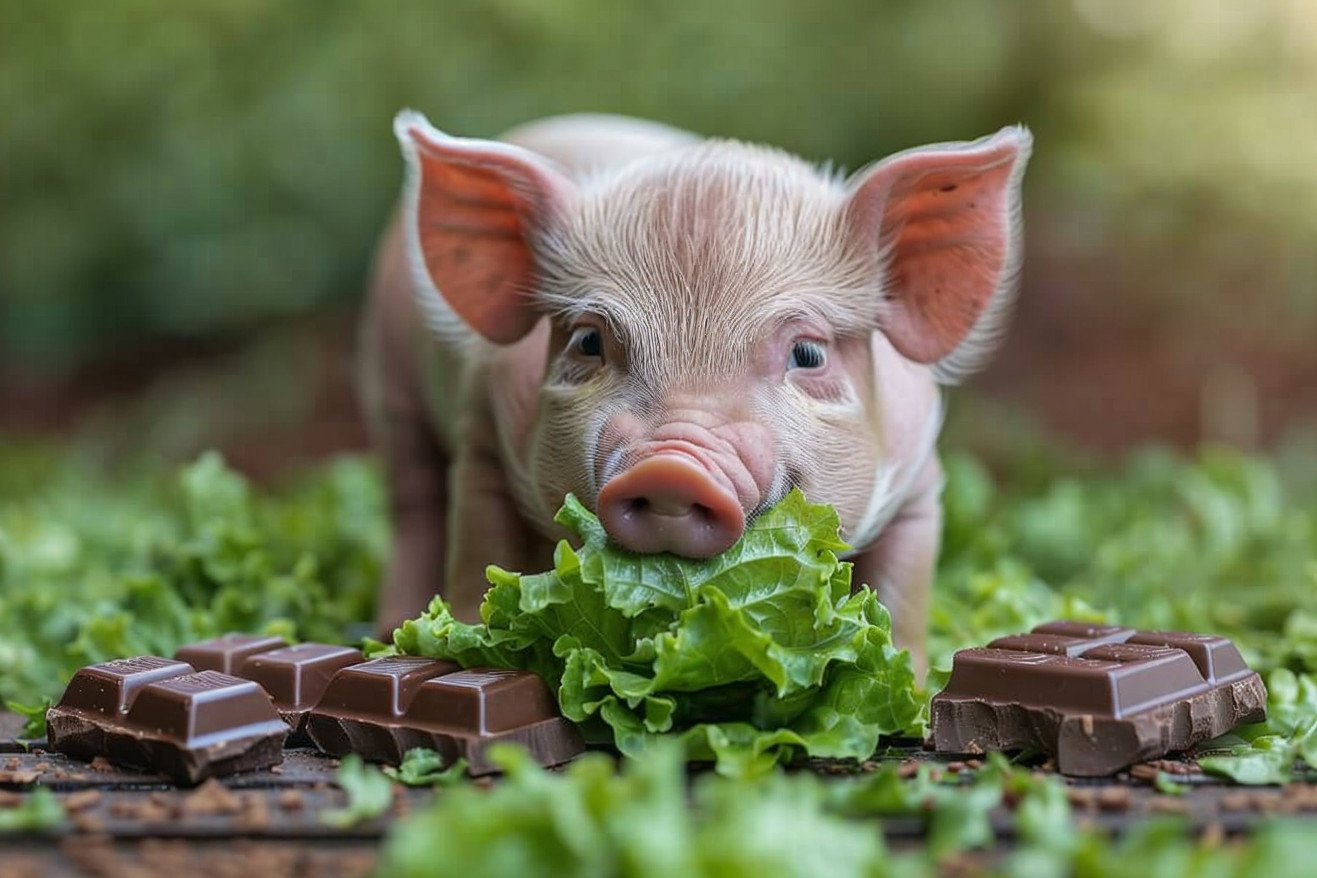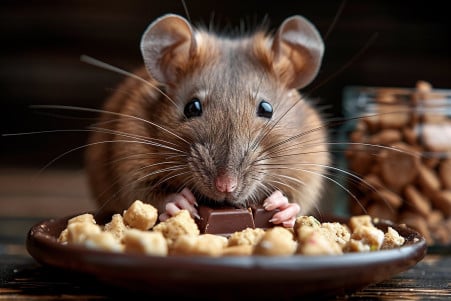Can Pigs Have Chocolate? Other Safe Treats for Pigs to Consider
6 March 2024 • Updated 6 March 2024

While the question of whether or not pigs can eat chocolate is interesting, it’s a food that most people don’t think of as a pig treat. Pigs can metabolize theobromine and caffeine in chocolate, unlike other animals, which means it can be safe for them to eat in moderation. However, because chocolate is high in sugar, it should only be fed to pigs as an occasional treat to avoid obesity and nutritional imbalances.
In the sections below, we will look at agricultural research, veterinary nutrition recommendations, and animal nutrition studies to better understand the risks and benefits of feeding chocolate to pigs. By the end of this article, you will understand the fine line between treat and toxin and the broader concepts of pig nutrition and feeding. This will help you understand how to feed pigs in a way that keeps them safe and healthy.
Can pigs have chocolate?
Theobromine and Caffeine Metabolism in Pigs
Theobromine and caffeine are the main compounds of concern in chocolate poisoning due to their toxic effects in many species, with dogs being the most well-known example. These methylxanthines, which are found in high levels in chocolate, can lead to chocolate toxicosis, which can result in symptoms like vomiting and hyperactivity, according to the Merck Veterinary Manual.
However, pigs have been shown to metabolize these compounds differently. While there are few studies that focus on pigs specifically, one study on piglets showed that caffeine could help with pre-weaning growth and survival, according to a paper available on PMC.
This indicates that pigs have a different way of metabolizing these compounds that allows them to tolerate a certain level of methylxanthines without the negative effects seen in other species.
More recent studies, including one published in Animals in 2023, have shown that caffeine can have positive effects on piglet vitality and physiological parameters.
While this research is promising, it also notes that the effects were only seen at low levels of caffeine and that high levels of caffeine had negative effects, showing that moderation is key.
These differences in metabolism have important implications for the inclusion of chocolate in pig diets. While this indicates that pigs can tolerate chocolate, it also shows that the potential dangers of overconsumption need to be recognized, and safe levels need to be determined to protect pigs’ well-being.
Nutritional Needs of Pigs
Pigs have specific nutritional requirements that must be met to ensure their well-being and performance. According to the Merck Veterinary Manual, pigs need six main categories of nutrients: water, carbohydrates, fats, protein (amino acids), minerals, and vitamins.
Energy, which is primarily provided by carbohydrates and fats, is also important, and proteins provide the essential amino acids needed for growth and reproduction. Minerals such as calcium and phosphorus are important for bone health, and vitamins are important for a variety of biological processes.
When it comes to treats like chocolate, think of them as supplements to a diet rather than a main source of nutrition. This is because chocolate doesn’t contain the essential nutrients that pigs need. While chocolate can provide some energy due to its sugar and fat content, it doesn’t provide the balanced nutrition that pigs need.
In addition, feeding pigs large amounts of chocolate can lead to obesity and other health problems due to its high sugar content, which cancels out any short-term benefits.
The nutritional requirements for pigs, as outlined by authoritative sources like the National Swine Nutrition Guide, stress the importance of a balanced diet that’s tailored to the pigs’ life stages and health.
Chocolate, as a non-traditional food item, doesn’t fit into these requirements well and should be fed in moderation so that it doesn’t replace the essential nutrients in a pig’s diet. This is important because it helps maintain nutritional balance and enables the delicate balance between providing treats and avoiding toxins to be maintained.
Balancing Reward and Poison
Chocolate serves a dual purpose in a pig’s diet: it is a reward and a potential poison that must be carefully managed by pig owners. Pigs can eat small amounts of chocolate without negative effects because they can metabolize theobromine and caffeine to a certain extent, but overconsumption can lead to serious health problems.
The consumption of large amounts of chocolate can result in issues with the nervous system and heart, especially in the case of dark and baking chocolate, which have higher levels of theobromine and are therefore more dangerous, according to New Life on a Homestead.
Instead of chocolate, pigs can be given a number of other treats that can be nutritionally beneficial and enjoyable. Fresh fruits and vegetables, for example, can provide pigs with essential vitamins and minerals, making them a healthy treat. This can help ensure safety and compliance with nutritional recommendations from sources like the National Swine Nutrition Guide.
It’s important to remember that everything should be done in moderation. A livestock nutritionist or a veterinarian can be an important resource for making sure pigs are getting the right nutritional balance and staying healthy. They can also provide personalized advice based on an individual animal’s nutritional needs and other factors, which can help ensure that treats continue to be a safe and enjoyable part of a pig’s diet.
Understanding the Complexities of Food Toxicity in Animal Diets
Understanding food safety and toxicity is important when thinking about the diets of companion animals, such as pigs. In contrast to pigs, cats and dogs are often more susceptible to the toxic effects of certain human foods due to their metabolic differences. For example, chocolate contains methylxanthines, including caffeine and theobromine, which are toxic to dogs and cats, but pigs metabolize these substances more efficiently.
That said, pigs are still susceptible to food toxicities. Raw meat, which can be contaminated with bacteria, and certain plants, such as rhubarb leaves and raw beans, which contain antinutritional factors, can be toxic to pigs. In general, the inability to metabolize specific substances is the underlying physiological cause of food toxicity and can lead to toxicity and associated health problems.
This background on food toxicity in pigs helps put the relative safety of chocolate into perspective. While the moderate consumption of chocolate may not be as dangerous as other toxic foods, the basic principles of animal toxicology still apply, and moderation and informed choices are key to ensuring the well-being of the animal.
Feeding a Pig’s Chocolate Craving: Can Pigs Eat Chocolate?
Our investigation shows that pigs can metabolize chocolate, and especially its theobromine and caffeine content, in a way that is similar to humans due to the similarities in their digestive systems. This means that pigs can eat chocolate and get some nutritional value from it since it does contain some energy and essential nutrients in limited quantities, which can be especially helpful post-weaning and during finishing.
However, the key to feeding pigs chocolate is in how it’s done.
The advice from Farming Base, New Life On A Homestead, and Animal World all centers around feeding pigs treats in a way that is responsible. This means that it’s important to control the amount of chocolate that pigs eat to avoid overfeeding, obesity, and other health problems that can come from too much sugar and fat.
It’s also important to work with a livestock nutritionist or a veterinarian to determine how to feed pigs chocolate, especially if you’re new to raising pigs.
In conclusion, while pigs can eat chocolate as a treat, it’s important to make sure that their dietary needs are met and to work with a professional to do so. This includes not only avoiding foods that are bad for pigs but also understanding how pigs’ unique digestive systems work so that you can feed them in a way that ensures they are healthy and happy.


